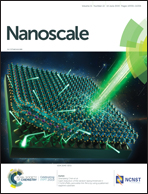Identification of a Nitrogen-related acceptor in ZnO nanowires
Abstract
Nanostructured ZnO, such as ZnO nanowires (NWs), is a promising material system for a wide range of electronic applications ranging from light emission to water splitting. Utilization of ZnO requires development of effective and controllable p-type doping. Nitrogen is considered among key p-type dopants though the exact origin of N-induced acceptors is not fully understood, especially in the case of nanostructured ZnO. In this work we employ electron paramagnetic resonance (EPR) spectroscopy to characterize N-related acceptors in ZnO NWs. N doping was achieved using ion implantation commonly employed for these purposes. We show that the Fermi level position is lowered in the N implanted NWs, indicating the formation of compensating acceptors. The formed acceptor is unambiguously proven to involve an N atom based on a resolved hyperfine interaction with a 14N nucleus with a nuclear spin I = 1. The revealed center is shown to act as a deep acceptor with an energy level located at about 1.1 eV above the top of the valence band. This work represents the first unambiguous identification of acceptors deliberately introduced in ZnO nanostructures. It also shows that the configuration and electronic structure of the N-related acceptors in nanostructures differ from those in ZnO bulk and thin-films. The present findings are of importance for understanding the electronic properties of nanostructured ZnO required for its future electronic applications.



 Please wait while we load your content...
Please wait while we load your content...